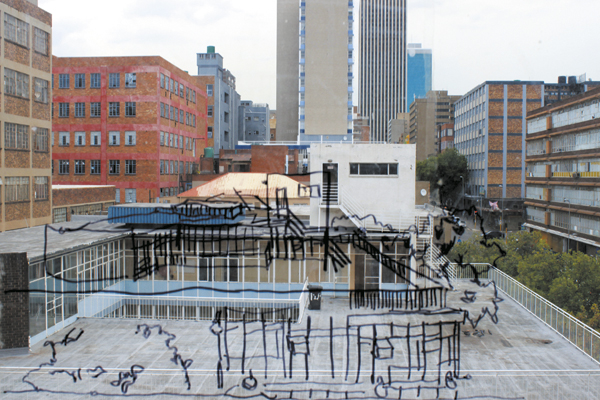chr-window-drawing
Gabi Ngcobo
Does this Window Have a Memory?
centerforhistoricalreenactments.blogspot.de
The ‚Center for Historical Reenactments‘ (CHR) is located inside August House, a nineteen-forties building at the east end of Johannesburg (affectionately known as Jo’burg), in an area called Doornfontein—the eighth of eleven regions of the city. The address is 76–82 End Street, a block flanked by Kerk and Pritchard Streets on its façade and Mosley Street on the east side. From the main window (see photo) on the right, one can see Kerk Street, from which coach buses that travel between Jo’burg and Zambia’s main cities, (Lusaka, Ndola and Kitwe) depart. On Pritchard Street, located on the left, coach buses that travel to and from Malawi’s main cities (Lilongwe and Blantyre), collect their passengers, whose presence in the area duplicates a particular liminal Malawian culture.
Walking through these streets one encounters many languages: Nyanja, Bemba, Chichewa, isiZulu, Shona, and many others, most of which I cannot recognize. The sounds and smells are also part of this cityscape. One very distinct sound is that of packaging tapes being used to seal and cover large and oversized packages in their entirety; furniture, clothing, food, appliances, etc., are prepackaged the day before departure. On Kerk Street, inside a newly renovated building you can eat Zambian food at the Kwacha Bar & Grill, (the Kwacha being a Zambian currency). Passengers can also stay at the hotel upstairs to be closer to the departure point for the Tuesday-Sunday 8:00 am exodus. Young unemployed boys and men loom around selling products and catering to the soon departing; packaging tapes, pens, permanent markers and passport holders. On this street two old buildings are used as collection and packaging points. A Chinese man who speaks little or no English sits outside the hotel building all day, talking to no one and sometimes reading a Chinese newspaper. I am told that his brother owns the three buildings catering to Zambians on the block. Directly to the right of the roof visible in the photograph—at the corner of Kerk and End Streets—is a nameless building whose condition has reached perhaps the most extreme deterioration imaginable. People live there but the smells stemming from the building tell us that we can hardly call that a life.
Also seen from the ‚CHR‘ window is “Jumbo” the pink elephant (a signal of the Jumbo liquor stores), standing on top of the roof of a one storey building right at the corner of Kerk and Nugget streets. On a plastered wall below “Jumbo” is a graffiti written in green spray paint: “GITO BALOI, NA KU RANZA” (GITO BALOI, I LOVE YOU). This is the exact point where thirty-nine year-old Baloi, a Mozambican musician who lived in Johannesburg, was shot dead on his way home from a concert on April 4, 2004.
The music that blurts out of the minibus taxis and neighboring shops is Maskandi, the Zulu folk music. This signals that the area’s largest population comes from one of South Africa’s largest provinces, KwaZulu-Natal (KZN). Having come from the same province, it is easy for me to quickly grasp the sensibilities and attitudes gathered here. Traditional medicine shops and stalls grace the cityscape, as well as sounds of the very distinct (almost monotonous) acoustic guitar associated with music from this province. The word “Dudlu,” uttered by Zulu men at the sight of a woman they desire, (which may very much mean all women), seems to be the area’s motto. Some have mistaken these sensibilities for aggression and indeed there are moments where this is very true. An aggressive environment demands an equally aggressive attitude. It demands that one be in sync with those sensibilities by wearing well-developed defenses that do not attract attention.
I often take neighborhood walks and often look for and pick up unassuming useful objects at next to nothing if anything at all. The mirror from the Indian man, who for decades and until recently ran a second hand clothing shop on Nugget Street, was free. It is oval-shaped with a back handle—the kind I imagine he held up to customers trying on items from his collections. The shop recently closed down without a scream or screech, and much to the man’s obvious distress about the unknown. I attribute this to the proliferation of the second hand clothing market located at the corner of King George and De Villiers Streets, in which dealers specialize in second hand items from Europe that range from ties, shoes, shirts, dresses and even underwear.
At four meters wide and 1.8 meters in width, the ‚CHR‘ window allows us to witness and imagine tensions of many forms taking place just beyond the glass. To paraphrase Igor Zabel, we are aware of the season of the year, or the time of the day, of the space’s location, and its natural, cultural, social, and historical context. [1] We were not here to witness the “xenophobic” attacks that broke out in 2008, but through the window we can almost imagine how this area was affected, and how tensions that triggered whatever may have arisen. We wanted to respond to these events—for which the window remains a primary witness—but more so to the failure of language to articulate trauma. We launched Xenoglossia, an ongoing research project that was mindful of Chinua Achebe’s words in which he wrote that, “Language is a handy whipping-boy to summon and belabor when we have failed in some serious way…” [2]
Xenoglossy is the alleged or rare condition of speaking or writing in a language entirely unknown to the speaker; it is a condition that is either disputed or explained through another contested phenomenon—that of reincarnation. Xenoglossia therefore allows us to respond to one major aspect of the attacks: language. The project explores how language has failed us and how it has played a central role in some of the gravest historical misunderstandings that have been reincarnated in recent history, in South Africa, and elsewhere in the world.
It considers events such as the 1976 Soweto student uprisings—an historical protest against Afrikaans being used as a language of instruction in black South African schools. We also take a closer look at the derogatory “words” such as “kwerekwere,” a word that attempts to mimic a sound of an unrecognized language, and one in which the 2008 misunderstandings that led to violence can best be located. Xenoglossia also goes as far as considering Caliban’s retort to Prospero and Miranda in William Shakespeare’s The Tempest (1610–11): “You taught me your language and my profit on’t is I know how to curse,” a slogan which has come to be used as a tool of cultural resistance and described by William Ashcroft as, “an evocative model of the post-colonial subject.” [3]
Xenoglossia allows us to look at issues pertaining to interpretation and translation, speech and speechlessness, the written text and the spoken word. Hlonipha Mokoena, (author of Magema Fuze: The Making of a Kholwa Intellectual, a long overdue book responding to the very first book written in the Zulu language in 1922), foregrounds the importance of looking at the first black South African interpreters (or native informants), who themselves had to deal with the shock of watching themselves being erased, and also how history repeats itself in the guise of progress. We draw equally from literature and art history, considering writers such as Lewis Nkosi and Dambudzo Marechera, and art movements such as the Italian Arte Povera movement, and the exiled South African MEDU Art Ensemble.
Our challenge is to bring “the outside” into our space while simultaneously establishing a context of engaged autonomy that relies on such a distance as facilitated by the glass window between the space and the outside; a crucial boundary across which existential relations maybe viewed with restrained eyes. Thus the ‚CHR‘ space becomes a site of artistic historical research. We foreground artistic practices that raise questions that help reshape the reception of a given historical context. Furthermore, ‚CHR‘ sets to investigate and create dialogues between artistic practices in order to reveal how, within their constellation, certain histories are formed or formulated, repeated, universalized and preserved. We employ citations, transversal research processes, subversion and mediation. These forms are strategies of revealing how art could perform transformative effects in political spaces that may not yet be recognized as sites of struggle, and how it may thus be allowed to enter a refreshed political sensibility. Historical reenactments, as we see them, allow for a politicization of history within the art context.
– –
[1] Igor Zabel, “The Return of the White Cube,” Manifesta Journal, no.1 Spring/Summer 2003, p. 19. /
Frühjahr/Sommer 2003, S. 19
[2] Chinua Achebe “Politics and Politicians of Language in African Literature” (1989) in The Education of a British Protected Child Alfred A. Knopf, New York, 2009 p. 96
[3] William Ashcroft, On Post-colonial Futures: Transformations of Colonial Culture, London, 2001, p. 4 / S. 4



